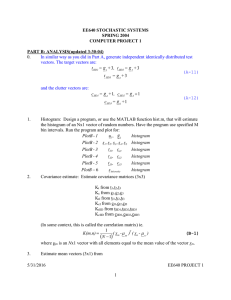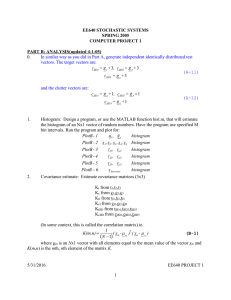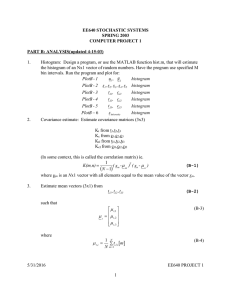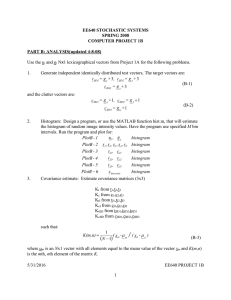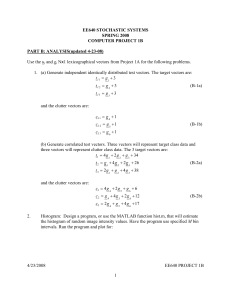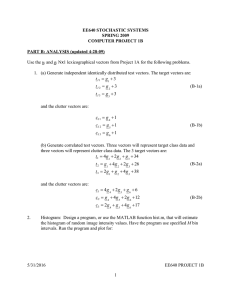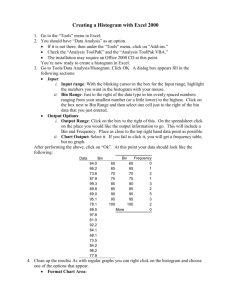EE640 STOCHASTIC SYSTEMS
advertisement
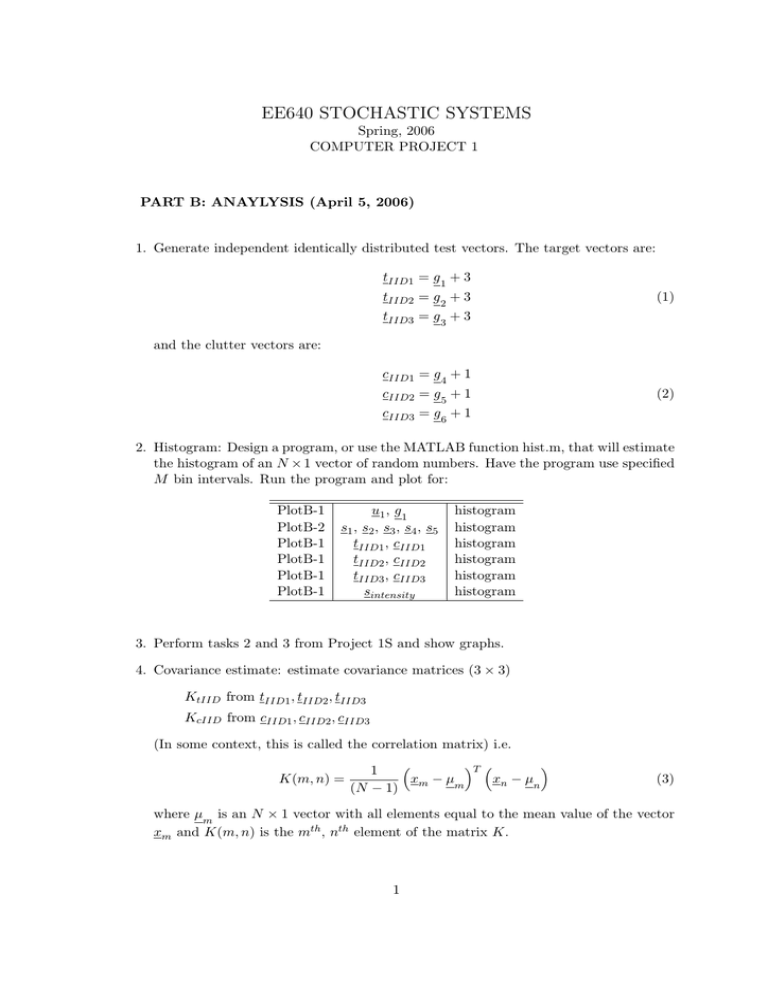
EE640 STOCHASTIC SYSTEMS
Spring, 2006
COMPUTER PROJECT 1
PART B: ANAYLYSIS (April 5, 2006)
1. Generate independent identically distributed test vectors. The target vectors are:
tIID1 = g 1 + 3
tIID2 = g 2 + 3
(1)
tIID3 = g 3 + 3
and the clutter vectors are:
cIID1 = g 4 + 1
cIID2 = g 5 + 1
(2)
cIID3 = g 6 + 1
2. Histogram: Design a program, or use the MATLAB function hist.m, that will estimate
the histogram of an N × 1 vector of random numbers. Have the program use specified
M bin intervals. Run the program and plot for:
PlotB-1
PlotB-2
PlotB-1
PlotB-1
PlotB-1
PlotB-1
u1 , g 1
s1 , s2 , s3 , s4 , s5
tIID1 , cIID1
tIID2 , cIID2
tIID3 , cIID3
sintensity
histogram
histogram
histogram
histogram
histogram
histogram
3. Perform tasks 2 and 3 from Project 1S and show graphs.
4. Covariance estimate: estimate covariance matrices (3 × 3)
KtIID from tIID1 , tIID2 , tIID3
KcIID from cIID1 , cIID2 , cIID3
(In some context, this is called the correlation matrix) i.e.
K(m, n) =
³
´T ³
´
1
xm − µm
xn − µn
(N − 1)
(3)
where µm is an N × 1 vector with all elements equal to the mean value of the vector
xm and K(m, n) is the mth , nth element of the matrix K.
1
5. Estimate mean vectors (3 × 1) from
tIID1 , tIID2 , tIID3 ,
(4)
µt,1
µt = µt,2
µt,3
(5)
cIID1 , cIID2 , cIID3 ,
(6)
µc,1
µc = µc,2
µc,3
(7)
such that
likewise for clutter, use
to generate
6. Repeat step 4 and 5 for the noisy image responses defined in item 6 of project 1A.
The responses should be from type 0 LPCCF, order k = 1, 2 and 3 filters. Note that
lexicographic form is used such that the covariance matrix is 3 × 3.
7. Determine the peak element locations, the centroid element locations of the histograms of bbinary and sintensity . The centroid is determined by “simulating” a pdf.
For example, lt x[n] be a sequence and you want to approximate E{x[n]}. Let h(x)
be the histogram of x[n]. First, form a pseudo pdf as
fx (x) =
h(x)
M
P
(8)
h[m]
m=1
where m is the bin number of a total M bins in the histogram. The value of h(x)
returns the bin value that contain the value of x. The centroid is then
µx =
N
X
x[n]fx (x[n])
(9)
n=1
Determine the time averages of bbinary and sintensity and compare with the centroid
averages. The should be close.
Optional Method: A conceptually easier technique for implementing the centroid is
the following: The approach will first get the fractional value of the estimated bin
number. Then that value is linearly mapped to the x dimension. Given your bin
numbers for the histograms h[m] are equally spaced and vary from 1 to M . We can
map bin values to signal values with xmin = a ∗ 1 + b and xmax = a ∗ M + b. So
a = (xmax − xmin )/(M − 1) and b = xmin − a. The value xmax and xmin are the center
values associated with the end bins. So we find the centroid
fm (m) =
h[m]
M
P
m=1
2
h[m]
(10)
The centroid is a fractional value
µm =
M
X
m=1
and the mean of x is then µx = µm ∗ a + b.
3
mfm (m)
(11)

